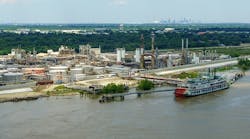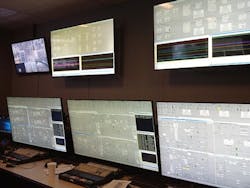Control System Modernization Achieves Multiple Goals
Chevron Oronite, a subsidiary of Chevron Corporation, is a leading developer, manufacturer and marketer of lubricant and fuel additives and chemicals. The company’s operations include world-class facilities in the United States, France and Singapore, as well as smaller-scale regional plants.
Chevron Oronite has embarked on a journey to achieve digital transformation — converting data to information, information to insights and insights to decisions. Naturally, the company also kept digital acceleration (i.e., speeding the transformation) in the forefront when starting an ambitious control-system-modernization planning effort as part of its lifecycle management strategy for control system assets. This focuses on upgrading the system for process control, improving workflow efficiencies and operator effectiveness, and digital acceleration initiatives, among other benefits.
Over the years, the company’s control platform has included a combination of legacy and new distributed control systems (DCSs) from Honeywell, programmable logic controllers, wireless systems, integration with enterprise resource planning systems, and more. Chevron Oronite’s strategic outlook on process automation, based on a roadmap for meeting its modernization requirements at its U.S. site, includes:
• Modernizing in a low-risk direction using a modular approach;
• Furthering the establishment of a multi-year roadmap and buy-in of all stakeholders; and
• Reaping early benefits from new technology such as by adopting some calculated “high-risk, high-return” measures.
The company required new ways to manage the lifecycle of its automation assets while employing new digital technologies combined with data-driven insights to transform operations, boost agility and enhance strategic decision-making. Like other manufacturers, it is managing the retirement of experienced personnel and the training of a new generation of workers not familiar with legacy DCS technology.
Stepping Into The Future
As part of a comprehensive control-system-modernization effort, Chevron Oronite established a multi-year migration plan and undertook one of the first major implementations in North America of Honeywell’s Enhanced High-Performance Process Manager (EHPM). It is a process-connected device on Honeywell’s Enhanced Universal Control Network (EUCN) that provides regulatory control and sequence operations. EHPM enables unification of control functions and data exchange between devices on the fault-tolerant-ethernet (FTE) based EUCN to help improve operations and control performance. It works in tandem with the updated Experion Local Control Network (ELCN) to preserve existing control applications, graphics and procedures in their entirety while allowing a plant to benefit from the capabilities of a new, advanced control system. This was followed with similar efforts in its Singapore location.
Chevron Oronite’s specific migration activities included:
• Retaining its legacy control applications while migrating to a modern control platform;
• Deploying EHPMs as peer-to-peer nodes with existing controllers;
• Using FTE technology to keep existing functionality and embedded applications; and
• Integrating legacy controllers within the new DCS infrastructure.
Planning for the modernization program started in 2013. The first phase — operator graphics conversion, human/machine interface (HMI) and control network implementation, and historian upgrades — began in 2014 and ended in 2017.
The second phase — domain upgrades, virtualization within the process control network, control system integration and implementation of advanced technology — started in 2017 and was completed in 2020.
The third and final phase of the program — migrating to the latest batch control systems, Experion Batch, and deploying modern unit operations controllers, advanced batch visualization, in-batch reporting, etc. — currently is in the implementation stage, covering both its U.S. and Singapore sites. This started in 2020 with two implementations, one each in the United States and Singapore that were completed successfully. In 2021, three more implementations are to occur at these two facilities.
All migration, modernization and upgrade work across these multiple global sites should finish this year, with systems being upgraded to the latest Exp R 520.x release.
Figure 1. Control room displays now feature a high-performance human/machine interface that follows Abnormal Situation Management Consortium guidelines.
Chevron Oronite is translating its modernization strategy to a digital vision by breaking down efforts into step-by-step deployments with clear value propositions:
• Extending the life of its modern control environment;
• Improving configuration and change management;
• Optimizing alarm and operations management;
• Moving laboratory data into the plant historian for a single source of information for process analysis, quick visibility for operators, etc.; and
• Enhancing operator effectiveness and agility through a high-performance HMI, procedural operations functions, advanced reporting, reference/golden batch, advanced batch visualization, etc.
Preserving Existing Investments
The key to the modernization is promoting that different generations of control systems can run in the same environment with a common, seamless interface for plant operators. Saving existing configured applications is a very important aspect of this initiative.
Chevron Oronite is upgrading or replacing current process controllers with modern Honeywell technology to enhance process control performance and address obsolescence. Its objectives are to retain control strategies, operator displays and history/trend information while minimizing disruption to plant operations. Modernization activities have addressed traditional local-control-network and architecture data flow challenges. In addition, they will provide a standalone, class-based, virtualized batch system without the need for a separate batch server.
The project team had the flexibility to choose either physical or virtual options — and opted for virtualization, with an eye toward reducing overall system footprint. Virtualization offered a way to preserve and extend investments in decades-old DCS technology. It also increased availability versus a physical platform and helped to simplify the control system architecture. The deployment of controllers and traditional control network nodes in a virtual environment will be the next major undertaking — which is expected to be completed this year following the Experion Batch implementation in its U.S. facility.
For Chevron Oronite, an important part of the modernization program involved upgrading how it detected and averted abnormal situations and implementing effective alarm management aligned with industry standards. This approach helped address alarm configuration problems and decrease alarm floods, established an alarm philosophy for the plant and reduced redundant alarms, and provided operators with a real-time view of the actions needed during an event. Furthermore, a robust boundary-management application now alerts operators to abnormal situations before alarm events occur.
Finally, the company has focused on lifecycle management to enhance its control system infrastructure. The scope of this effort encompasses the DCS, along with control network installations. Migration will help ensure a common DCS front-end platform across all control rooms while keeping the back end on a combination of legacy and new technology.
Changing With A Vision
When it comes to accelerating digital transformation, Chevron Oronite plans to better manage the lifecycle of its critical control-system assets while providing leadership with enhanced data-driven decision-making capabilities. The company has shown that change must be driven with a vision using a bottom-up and top-down approach, from management and business leaders to plant operators and field technicians.
The ongoing migration, modernization and upgrade work is making sure operations are up to par with current technology; improving operator effectiveness through abnormal situation management, integrated alarm management, automated procedures, etc.; expanding interfaces to the business and third-parties; streamlining data flow from business to DCS and implementing better analytics.
In terms of reaping early benefits, Chevron Oronite’s migration strategy provides an effective means of dealing with aging control system technology. This technology, if left unattended, could undermine plant operations and net operating profits because of reduced availability of aged DCS components and knowledgeable resources, as well as increased operational costs related to component failures.
Opting for EHPM allowed modernizing the “heart” of the control system — process controllers — while retaining existing input/output, control strategies, displays and advanced control. At the same time, modernization via EHPM and ELCN enabled the company to take advantage of new functions and technologies such as virtualization platforms, FTE and tighter control system integration.
Chevron Oronite has found that a digital platform for process control can directly increase workflow efficiencies and operator effectiveness. For example, the new technology enables the company to meet change management requirements within its process control environment simply. It can easily determine interactions with the control system; identify when configuration changes were made; and collect and report on system information, configuration history and performance conditions. Honeywell Trace data collection software implemented last year at its U.S. facility also has expanded the visibility of configurations while automating the documentation of actions taken by plant workers.
Gaining Important Benefits
Chevron Oronite has achieved flexibility and adaptability with its automation technology upgrades. The company’s modernization program supports information technology (IT)/operational technology (OT) convergence to eliminate boundaries between IT and OT technologies.
The company has demonstrated that early adoption of new technologies comes with potential risks but can offer significant rewards such as eliminating downtime for system upgrades and preserving valuable configured applications and other legacy assets. Control room operators have gained a future-ready platform that allows them to stay ahead of the technology curve. This paves the way for continuous evolution and the next step in the company’s migration journey — more-modern DCS-integrated tools/capabilities and data-driven visualization with new tools providing first-hand information of what is yet to happen in the process.
Most importantly, Chevron Oronite is fostering a culture in which automation, process operations and IT work together as a collaborative team to significantly help improve business results. Now, the company has a clear path to a sustainable future, which allows for technology upgrades while harmonizing new and existing assets, increasing the life expectancy of installed hardware and software, and reducing total cost of ownership with less risk and greater efficiency.
NATARAJAN MUTHAIAH is a process control systems project manager for Chevron Oronite, stationed in Belle Chase, La. MARJORIE OCHSNER is a senior offering manager — migration solutions for Honeywell Process Solutions, Phoenix. Email them at [email protected] and [email protected].



